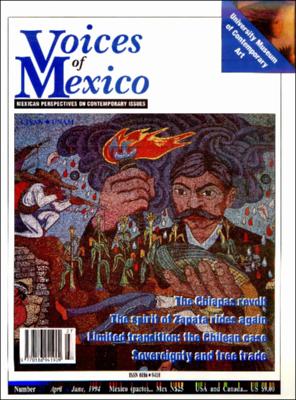Mostrar el registro sencillo del ítem
Voices of Mexico: Mexican Perspectives on Contemporary Issues
| dc.rights.license | http://ru.micisan.unam.mx/page/terminos | |
| dc.contributor.editor | Toro Gayol, Marybel | |
| dc.contributor.other | Velasco Montante, Astrid | |
| dc.date.accessioned | 2018-12-04T00:35:45Z | |
| dc.date.accessioned | 2022-02-17T00:15:47Z | |
| dc.date.available | 2018-12-04T00:35:45Z | |
| dc.date.available | 2022-02-17T00:15:47Z | |
| dc.date.issued | 1994 | |
| dc.identifier.issn | 0186-9418 | |
| dc.identifier.uri | https://ru.micisan.unam.mx/handle/123456789/16734 | |
| dc.format | application/pdf | |
| dc.format.extent | 104 pp. | |
| dc.language.iso | eng | |
| dc.publisher | Universidad Nacional Autónoma de México, Coordinación de Humanidades, Centro de Investigaciones sobre América del Norte | |
| dc.relation.isformatof | ||
| dc.relation.haspart | Our Voice / Margáin, Hugo B.; The Mexico of Santa Anna, the Seducer; John Reed Arrived in Mexico Eighty Years Ago / Sánchez de Armas, Miguel Ángel; Mexico for the Political Expatriate: Heaven or Last Resort? / Anhalt, Diana; The Franz Mayer Museum Rivero Borrel, Héctor; The Uncertain Course of Finance Arroyo, Abelardo; Elías Nandino, A Poet of Vitality and Talent Montiel Ziegler, Elsie; The Cathedral of Mexico City / Velasco Ballesteros, Maricarmen; Mexican Children in Pictures; Pilar Medina and the Ear of Corn / Rábago Palafox, Gabriela; James Wilkie, Mexico Studies and Current Border Issues Glusker, Susannah; Adela Breton, A British Artist in Mexico Torre y Rabasa, Mario de la / Rescue of a Cameraman: The Lost Images of Eustasio Montoya/ Moral González, Fernando del The Censoring of Birth of a Nation / Cruz, Carlos; How Presidential Succesion Works in Mexico Cárdenas, Graciela/ Montiel Ziegler, Elsie; Two Languages, One World / Henestrosa, Andrés; Contemporary Chicano Literature / Montiel Ziegler, Elsie/ For a Linguistic Policy without Borders Toro Gayol, Marybel; The Birthday Party/ Valero, L.F.; The Mexicans/ Glusker, Susannah | |
| dc.relation.requires | Adobe Acrobat | |
| dc.subject | HUMANIDADES Y CIENCIAS DE LA CONDUCTA | |
| dc.title | Voices of Mexico: Mexican Perspectives on Contemporary Issues | |
| dc.audience | Estudiantes | |
| dc.audience | Maestros | |
| dc.audience | Investigadores | |
| dc.audience | Otros públicos | |
| dc.audience | Medios de comunicación | |
| dc.contributor.assistanteditor | Montiel Ziegler, Elsie | |
| dc.contributor.assistanteditor | García Chávez, Alonso | |
| dc.contributor.businessmanager | Ocampo, Consuelo | |
| dc.contributor.corrector | John, Steven S. | |
| dc.contributor.designer | Noriega, Ricardo | |
| dc.contributor.designer | Belmar, Marco Antonio | |
| dc.contributor.editorinchief | Margáin, Hugo B. | |
| dc.contributor.layout | Glypho, Taller de Gráfica | |
| dc.contributor.printer | Artes Gráficas Panorama | |
| dc.contributor.salesandcirculationmanager | Del Rivero, Fernando | |
| dc.contributor.translator | Stephens, Suzanne | |
| dc.contributor.translator | John, Steven S. | |
| dc.contributor.translator | Dashner, Heather J. | |
| dc.contributor.translator | Valero, L. F. | |
| dc.coverage.placeofpublication | México | |
| dc.date.printcopyrighted | 1994 | |
| dc.description.extract | The Franz Mayer Museum is one of Mexico City"s most important, housing one of our country"s richest collections of art. Mayer was financially successful in Mexico and used his wealth to acquire works of art from our past. He enjoyed living amidst the works he collected in his house in Mexico City"s Las Lomas district. His collections of Colonial screens, ceramics from various parts of the country, silver extracted from our mines and transformed into works of art, and the religious sculptures known as estofados are among the most important to have been gathered by private collectors. Rare books made up part of his splendid library. All this he left to the people of Mexico. For its part, the government organized, restored and arranged Franz Mayer"s collections in the Women"s Hospital building which dates from the Colonial period. The remarkable Franz Mayer Museum is located in Mexico City"s "Historie Center," where it provides our country with the example of the generosity of a foreigner, who will always be remembered with admiration for the cultural appreciation reflected in his collections, and with gratitude for the legacy he left us. The museum"s director gives us a more complete picture in this issue. Adela Breton was a distinguished Englishwoman who carne to Mexico at the end of the last century. She fell in love with the Maya region, making special trips to paint and photograph the ruins of that great civilization, as well as painting and photographing the Mexican cities of her day. She was always accompanied by a Maya guide who watched over and cared for her whenever she visited Mexico. Thus, even when working incommunicado in the middle of the jungle, she was never in danger. She always fondly remembered Mexico"s people for the kindness she experienced here. Her magnificent work has been of considerable assistance to students of the Maya region, providing a realistic picture of the cities she depicts. Her paintings were exhibited in Chapultepec Castle. The large crowds that went to see them admired Adela Breton as an Englishwoman who made our treasures known in Europe. John Reed was an American journalist and writer who was present during the Revolution that toppled the dictatorship of Porfirio Díaz. He met Villa and learned of his hopes for social progress. He heard the revolutionaries" demands.. "Land and freedom," "Bread for all." Through his writing, Reed supported the movement"s social demands. In this issue we take note of his work. Mexico City"s Cathedral, built in the center of old Tenochtitlán, was the continent"s first. In addition to being the country"s most important church, it holds within it treasures of our past and altars from the Colonial era. The cathedral is sinking visibly, and this has affected its domes and pillars. A team of technicians, engineers and builders has undertaken large-scale works aimed at restoring the foundations of this invaluable national monument. The figure of Santa Anna covers a period extending from Mexico"s Independence through the middle of the last century. An agile interview with the author of the most recent book on this figure describes the history of President Santa Anna. The work, which will fill two more volumes, covers one of the most important eras of Mexico"s history: Spain"s attempted reconquest by means of the Barradas expedition, the 1836 war with Texas and the United States military intervention which carved up our territory in 1847. The writer Andrés Henestrosa has been awarded the Belisario Domínguez Medal, named for a senator who championed freedom of speech and was assassinated during the reign of Victoriano Huerta. Henestrosa, one of our magazine "s most distinguished collaborators, has written an interesting article on language for this issue. Mexican-American writers have produced a trend known as "Chicano literature," an increasingly dynamic contemporary expression of the cultural syncretism of communities of Mexican origin in the United States. Chicanos" cultural expression has been so outstanding as to become a subject of study and admiration both within the United States and here in Mexico. This community has striven to maintain its identity in the midst of a hostile environment, and has succeeded in doing so thanks to such men as Cesar Chavez. In this issue we also highlight the Nobel Prize for Literature awarded to Toni Morrison, which is of special note since this is the first time the prize has been awarded to an Afro-American woman writer. Morrison"s sensibility demonstrates the ability to overcome, and deserves to be admired worldwide | |
| dc.discipline.clase | Multidisciplina | |
| dc.educationlevel | Medio superior | |
| dc.educationlevel | Superior | |
| dc.educationlevel | Posgrado | |
| dc.identifier.cisan | VOM_1994_0027 | |
| dc.identifier.conacyt | CONACYT | |
| dc.relation.issued | 27, April-June, 1994 | |
| dc.rights.accesslevel | openAccess | |
| dc.rights.creativecommons | http://creativecommons.org/licenses/by-nc-nd/4.0 | |
| dc.subject.conacyt | 4 | |
| dc.type.spa | other | |
| dc.view.accesslevel | DISPONIBLE |
Ficheros en el ítem
Este ítem aparece en la(s) siguiente(s) colección(ones)
-
Números completos [125]
MiCISAN, Repositorio Institucional
Hecho en México, todos los derechos reservados 2018. Esta página puede ser reproducida con fines no lucrativos, siempre y cuando no se mutile, se cite la fuente completa y su dirección electrónica. De otra forma, requiere permiso previo por escrito de la institución.
Sitio Web administrado por: Centro de Investigaciones sobre América del Norte • micisan@unam.mx








